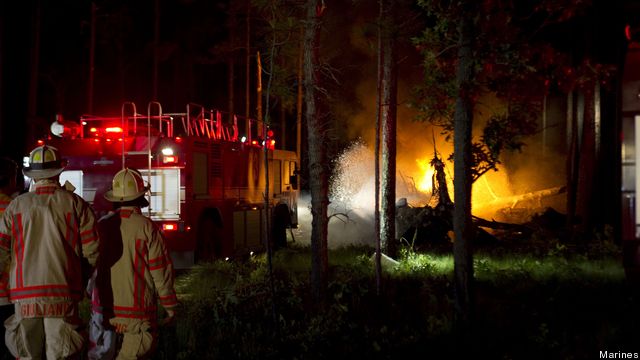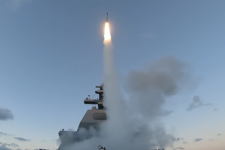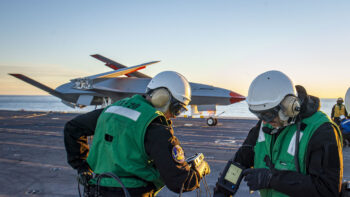 An Air Force investigation released Thursday found by “clear and convincing evidence” that the pilot of an Air Force CV-22B Osprey “inadvertently” flew through the turbulent rotor wake of another Osprey near Eglin Air Force Base in June, causing his tiltrotor transport to suddenly roll left and crash into a stand of tall pine trees.
An Air Force investigation released Thursday found by “clear and convincing evidence” that the pilot of an Air Force CV-22B Osprey “inadvertently” flew through the turbulent rotor wake of another Osprey near Eglin Air Force Base in June, causing his tiltrotor transport to suddenly roll left and crash into a stand of tall pine trees.
The report seemed to excuse the two pilots, who weren’t named in the document but have been previously identified as Maj. Brian Luce and Capt. Brett Cassidy, who was copilot on the flight but at the controls when the crash began. The report said that “CV-22 wake modeling is inadequate for a trailing aircraft to make accurate estimations of safe separation from the preceding aircraft.”
The pilot at the controls of the Osprey that crashed, Cassidy, “did not maintain the required 25 feet of vertical separation” from the lead aircraft but “was two- to three times” farther back from the lead than stipulated in flight manuals, the report added.
“Specification of a minimum of 250 feet cockpit-to-cockpit separation between aircraft in formation and charts depicting aircraft wake effects extending only to 375 feet can potentially give a false sense of security to aircrews flying at significantly greater distances in trail,” the report said.
Air Force Special Operations Command spokeswoman Capt. Kristen Duncan said AFSOC commanders would decide separately whether the pilots’ conduct in the accident warranted any disciplinary action.
No one was killed in the accident, which Luce and Cassidy almost prevented after the roll began by manipulating the controls to recover, according to the report. The $78.5 million Osprey was a total loss and all five crew aboard, members of the 8th Special Operations Squadron at Hurlburt Field, Fla., suffered injuries that required hospitalization. As Breaking Defense has previously reported, Luce was copilot of the only CV-22 ever destroyed in a fatal crash, an Osprey that went down during a night mission in Afghanistan on April 8, 2010, killing the pilot at the controls and three others among 20 troops and others aboard.
The release of the Air Force report, and the fact that it found no fault with the Osprey itself, provides more evidence Japanese officials have said they need to grant their approval for plans to station two squadrons of MV-22Bs at Marine Corps Air Station Futenma on Okinawa. Local concerns about the Osprey’s safety, despite a record that ranks it among the safest rotorcraft the Marines fly, led Japan’s government to insist that none of an initial dozen MV-22Bs that were shipped to Japan in July fly without their consent.
The CV-22B, like the Marine Corps MV-22B, can take off and land like a helicopter but fly like an airplane by tilting up or forward two wingtip pods called nacelles that hold its engines and rotors. The Florida accident occurred June 13 at 6:40 p.m. local time and only seven minutes after takeoff as the two Ospreys were flying from Hurlburt to the Eglin Range Complex to conduct formation flight gunnery training. In the training, a crew member in the CV-22B flown by Cassidy was supposed to fire a machine gun mounted on the aircraft’s open rear ramp at ground targets as they flew at 80 knots with the nacelles tilted upward at an 80-degree angle.
The accident began when the lead aircraft began a left 180-degree turn at 30 degrees of bank angle to take the Ospreys over the gunnery range. During the turn, the report said, the lead aircraft descended from 366 to 336 feet – a change in altitude that gave Cassidy “a false impression that he had adequate vertical separation,” the report said. As the lead Osprey turned, Cassidy began a brief right turn himself at 354 feet altitude to gain separation, then immediately banked left at a 30 degree angle.
“This maneuver never took the MA (mishap aircraft) directly behind” the lead aircraft, the report said, but Cassidy’s Osprey did cross the lead’s rotor wake. When the left rotor of Cassidy’s Osprey entered the lead aircraft’s wake, the Air Force report said, his CV-22B “immediately began an uncommanded roll to the left.” Luce “placed his hands on the flight controls and both he and (Cassidy) attempted to recover” from the roll, the report said, but while they were able to get the wings level, they were “unable to arrest the descent rate” before their aircraft hit the trees and then the ground. Contrary to early reports suggesting it landed on its back, the Osprey hit the ground with the nose slightly up and the nacelles up at 80 degrees, the report said.
The Osprey’s rotors, 38 feet in diameter, create particularly strong downwash in part because they are smaller than optimum for an aircraft its size and weight — a feature dictated by a requirement that the V-22 fit on the deck of an amphibious assault ship. The Osprey’s rotor wash is powerful enough that pilots are trained to keep at least 250 feet separation between their cockpit and that of a V-22 flying ahead when flying in formation in helicopter mode.
Marine Corps and Air Force flight manuals also admonish pilots when flying in such situations to avoid the lead aircraft’s 5 to 7 o’clock position, to fly at least 25 feet higher than the lead in any event, and to increase that separation to 50 feet when forced to cross the lead’s rotor wake during a formation turn. Formation flying, however, is something Air Force Special Operations Osprey pilots get little of, according to pilots in both services, which can make it hard for CV-22B operators to accurately judge situations such as the one Cassidy found himself in.





















